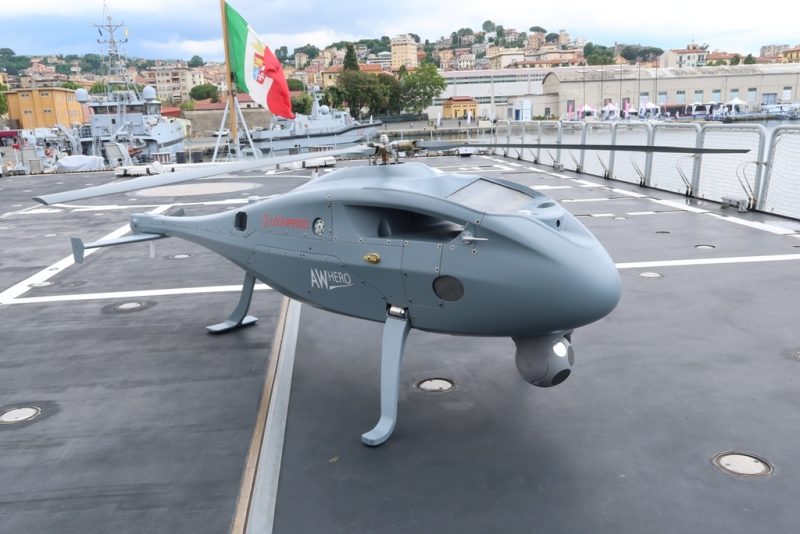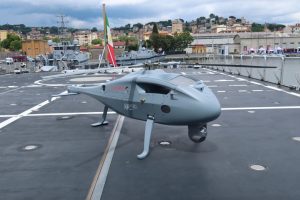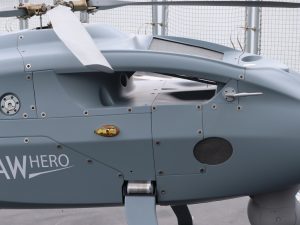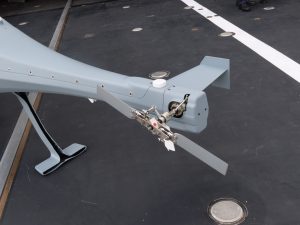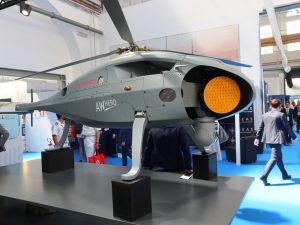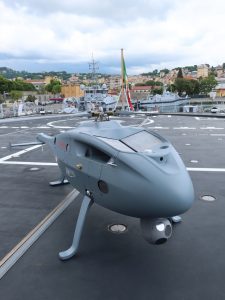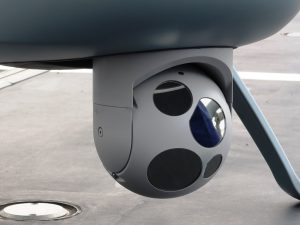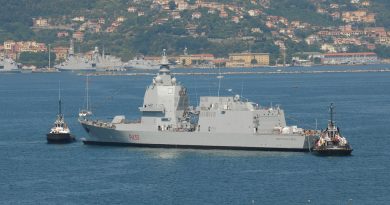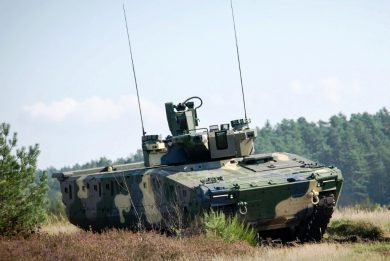SeaFuture 2023 – Leonardo unveils the latest iteration of its AWHero VTOL UAS
At SeaFuture 2023 Leonardo unveiled the evolution of its AWHero VTOL UAS, this rotary wing unmanned system that has been around for some time having been deeply modified in order to exploit lessons learned in many tests, including the Ocean 2020 initiative
The flight deck of ITS Thaon di Revel, the first-of-class Italian Navy PPA, hosted the unveiling ceremony of the latest evolution of the AWHero rotary wing UAS developed in the past by Leonardo, which has now evolved into an aircraft that is much closer to Italian Navy requirements. The unveiling was done on Day 1 of the La Spezia exhibition and conference, in the presence of the Italian Minister of Defence, Guido Crosetto, the Italian Navy Chief, Adm. Enrico Credendino, Leonardo co-General Manager Lorenzo Mariani, and a number of foreign delegations.
“When eight years ago the Naval Law was approved it was already clear that the first PPA would host unmanned air systems on board to perform ISR missions,” Mariani stated in its introductory notes.
Underlining the importance of the cooperation with Italian authorities and that of numerous operational exercises carried out in the past few years, Gian Piero Cutillo, the Managing Director of Leonardo’s Helicopters Division, cited Ocean 2020 as the event that has shown how much systems like the AWHero RUAS can extend the capabilities of the Navies. “The AWHero falls in the 200 kg category, however we are looking at heavier systems,” Cutillo said. He also underlined the key factors in the AWHero development that are full radar integration into the airframe, full automatic take-off and landing capability from the flight deck, and full integration of the RUAS system into the ship combat management system.
The task of detailing the technical evolution of the new AWHero was left to Clive Scott, Head of Programmes at Leonardo, who underlined that the previous version of the AWHero was certified in 2021, the work done in the next few years aiming at improving the certified configuration.
The AWHero looks new at first glance, as the fuselage has been totally redesigned. Fully composite, the previous one was metallic, it is build around the airframe mechanics and avionics, and not only this managed to spare around 10 kg, but it also allowed to make it easier to produce and, key for operations, to considerably improve maintainability as the fuselage can be easily disassembled to provide easy access to all internal components.
Among these we find the two new heavy fuel rotary engines adopted in the new AWHero, in place of the single gasoline engine of the original version. Leonardo did not unveil the name of the company producing those engines, which EDR On-Line understood each providing 30-35 hp. However Mr. Cutillo stated that Leonardo is acquiring the license for producing those engines, the Wankel solution providing good reliability, good power density and allow using the same heavy fuel available on board, a considerable advantage to reduce the logistic footprint. This, together with the fact that the AWHero has no hydraulic systems on board, also increases safety.
EDR On-Line understood that the new AWHero will firstly be certified with two engines running, however in perspective flight with a single engine will definitely be considered, the 60-70 hp power being required only for take-off and hovering, less than half being needed for horizontal flight. According to Leonardo a heavy fuel engine running at constant rounds per minute and low power does not burn fuel properly generating considerable foul that requires frequent engine overhaul, roughly every 100 hours. The company aims in the future to qualify the AWHero also for single-engine flight, in order to use it at higher power thus decreasing by five times overhaul issues. The two engines are located ahead of the rotor mast, the two radiators being located on top of the fuselage. This is carachterised by a void area over the engines which task is to improve engine cooling, Wankel engines generating a considerable heat, by extracting laterally the heat.
The three-blade rotor and transmission were not modified, showing the growth potential of the latter as the new engines provide a much higher power; the two-blade tail rotor was also maintained, albeit the pitch was slightly modified, and is now carried on a longer tail, its length being increased by 0.3 metres. The tail rotor is located on the left side while on the right side we find the horizontal stabiliser. The new tailplane architacture does not feature anymore the vertical stabiliser. Designed for naval use, the main rotor blades are foldable; the operation is carried out manually, a minimal force being applied to overcome the elastic blocking, This further reduces the already limited footprint, allowing the AWHero to be operated alongside a manned helicopter on mosy ships provided with a hangar.
Another feature that characterises the new AWHero is the landing gear; the two lateral skids are now replaced by a rear tricycle gear that according to Leonardo ensures a much better stability on the flight deck and improves the field of view of the chin-mounted optronic gimbal. The two front elements of the landing gear are in fact a single structure which elasticity ensures damping when landing on the flight deck.
The core avionics was maintained; the AWHero is a fly-by-wire aircraft and a single ground control station can handle two aircraft at the same time. The automatic take-off and landing system was qualified in the previous version and is based on a radiofrequency signal, a satellite system guiding the AWHero to the flight deck. However in perspective the company is working at visual landing systems that should provide even higher accuracy and reliability. This is also true for the navigation system, currently based on a GNSS/INS platform, the inertial component ensuring positioning even in GNSS-denied environment, although at lesser accuracy due to the drift. Leonardo highlights however the effectiveness of the antijam GNSS antenna fitted to the airframe. Currently the AWHero operates mainly on a planned path set by waypoints, which can be reprogrammed from the ground control station during the mission, however Leonardo is already working at Artificial Intelligence insertion to increase its autonomy. It is to note that the AWHero has its own on-board camera, which adds to the optronic payload.
Coming to payload all speakers made it clear that the radar is a must and is required by all navies, Leonardo installing in the AWHero its Gabbiano T20 X-band naval radar capable to provide high resolution SAR/ISAR imaging with submetric resolution. According to Leonardo its RUAS is the only in its category to be fitted with a purposely designed maritime radar. The new AWHero features two payload bays, one in the nose and one rear under the belly, the central part being used by the fuel tank which is obviously put in the best possible position to maintain the centre of gravity as constant as possible. The adoption of modular bays allows easy reconfiguration to tailor the airframe to mission. The time required to shift from one configuration to another can vary considerably ranging from half an hour to some hours, the air system being made ready within the same day.
The AWHero maximum take-off mass was increased from 220 to 240-250 kg, of which 70-80 kg are reserved for fuel and operational payloads. Considering a 5-6 hours endurance, an increase of around 20% compared to the previous configuration, the operational payload is of 35-40 kg. This allows installing an 8-inch optronic gimbal in the nose and the radar, both hosted in the forward payload bay. Different configurations such as that with a bigger gimbal are being considered, without radar, although the latter is considered a key element in naval operations as it allows the ship to operate passive, long range detection being ensured by the airborne radar operating at distance from the mothership. A third party data link is installed on board the AWHero that EDR On-Line understood being capable to generate a communications mesh. Installing the same data link on board manned helicopters would allow manned-unmanned operations, an option tested with the previous model during Ocean 2020. Leonardo is also considering installing a Rover link to allow operators on the ground to exploit images and data provided by airborne sensors, something that might be key, for example, in amphibious operations.
“We are already considering taking on board Electronic Support Measures while some potential customers are also asking for an IFF,” Clive Scott told EDR On-Line, external payloads being also considered.
The airframe seen on board ITS Thaon di Revel was a mock-up fitted with a 10-inch gimbal. On Day 2 of SeaFuture the same mock up was exhibited in the Leonardo boot fitted with a different front payload module; the cutaway allowed to see the layout of the Gabbiano radar and of the 8-inch gimbal, which should be the standard payload of this RUAV. The first prototype started flying in November 2022 and is currently continuing tests at an undisclosed military range. Two more prototypes are in advanced assembly stage, one to be delivered the week after the exhibition while the second should follow one month later. This will allow to speed up the opening of the flight envelope, certification being expected within 2024; initial certification will see the AWHero flying at temperatures up to 35°C, the next step aiming at 45°C.
Leonardo is in discussion with numerous potential customers, operating mainly in the maritime environment, and aims at finalising the first contracts within year-end. According to the head of Leonardo Helicopter Division, the national customer is showing a strong will to include unmanned air systems on board its ship. “We do not want to provide them with a system but with a capability,” Cutillo underlined, “therefore we want to design it with the customer and fully integrate it on his naval platforms,” he concluded.
Photos by P. Valpolini

